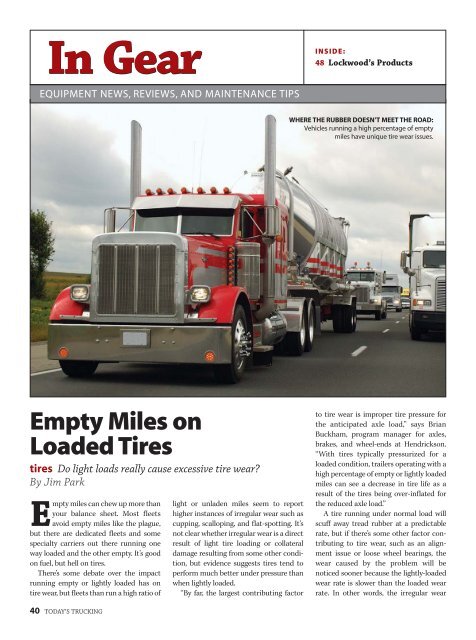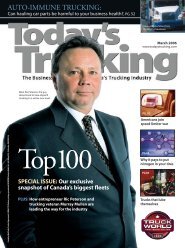You also want an ePaper? Increase the reach of your titles
YUMPU automatically turns print PDFs into web optimized ePapers that Google loves.
<strong>In</strong> <strong>Gear</strong><br />
EQUIPMENT NEWS, REVIEWS, AND MAINTENANCE TIPS<br />
Empty Miles on<br />
Loaded Tires<br />
tires Do light loads really cause excessive tire wear?<br />
By Jim Park<br />
Empty miles can chew up more than<br />
your balance sheet. Most fleets<br />
avoid empty miles like the plague,<br />
but there are dedicated fleets and some<br />
specialty carriers out there running one<br />
way loaded and the other empty. It’s good<br />
on fuel, but hell on tires.<br />
There’s some debate over the impact<br />
running empty or lightly loaded has on<br />
tire wear, but fleets than run a high ratio of<br />
40 TODAY’S TRUCKING<br />
light or unladen miles seem to report<br />
higher instances of irregular wear such as<br />
cupping, scalloping, and flat-spotting. It’s<br />
not clear whether irregular wear is a direct<br />
result of light tire loading or collateral<br />
damage resulting from some other condition,<br />
but evidence suggests tires tend to<br />
perform much better under pressure than<br />
when lightly loaded.<br />
“By far, the largest contributing factor<br />
INSIDE:<br />
48 Lockwood’s Products<br />
WHERE THE RUBBER DOESN’T MEET THE ROAD:<br />
Vehicles running a high percentage of empty<br />
miles have unique tire wear issues.<br />
to tire wear is improper tire pressure for<br />
the anticipated axle load,” says Brian<br />
Buckham, program manager for axles,<br />
brakes, and wheel-ends at Hendrickson.<br />
“With tires typically pressurized for a<br />
loaded condition, trailers operating with a<br />
high percentage of empty or lightly loaded<br />
miles can see a decrease in tire life as a<br />
result of the tires being over-inflated for<br />
the reduced axle load.”<br />
A tire running under normal load will<br />
scuff away tread rubber at a predictable<br />
rate, but if there’s some other factor contributing<br />
to tire wear, such as an alignment<br />
issue or loose wheel bearings, the<br />
wear caused by the problem will be<br />
noticed sooner because the lightly-loaded<br />
wear rate is slower than the loaded wear<br />
rate. <strong>In</strong> other words, the irregular wear



